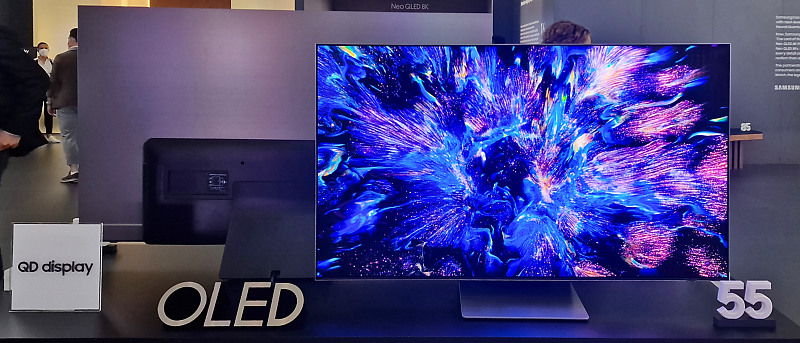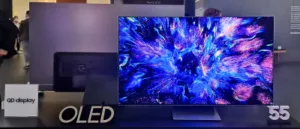Samsung’s TV business currently has access to what I (and pretty well everyone I know in TV!) consider to be the best quality TV panel technology in the world (as long as you are not in very bright ambient light). But sales levels are a problem. How did that happen?

The story that we have been reporting over a number of years is:
- Samsung Display Corp (SDC) decided to move to emissive OLED-based technologies away from LCD. LCD-making was fundamentally a finance and investment business and not so much a technology-driven business. David Barnes used to say that from an economist’s point of view, the margin structure of making LCDs looked like retailing, but with a very expensive shop (well, it’s a fab, but it doesn’t earn any more than having a shop).
- SDC decided that it would develop QD-OLED technology based on blue OLED emitters and quantum dots to convert blue to red and green for its main TV panels as it exited the LCD business.
- Samsung’s TV business (Visual Display/VD) decided that it didn’t want to use the QD-OLED technology. My understanding was that VD thought that too many different types of display technology would confuse customers. LED-backlit LCD for the mainstream and miniLED LCD and microLED at the high end were seen as enough to give a range of technologies. Adding QD-OLED, it was thought, would only confuse things (more on this later).
- ‘Persons close to the subject’ have also told me that VD was concerned about the risk of a big bet on QD-OLED. SDC had previously tried and failed to develop RGB OLED with LTPS backplanes with reasonable production efficiency and so there was a nervousness in committing to the technology.
- SDC decided to stop making LCDs for TVs (it had already stopped notebook and panels for other applications). VD, however, was not happy at that time with the quality of panels that it was getting from other LCD suppliers in China and wanted SDC to continue to supply LCDs for a longer time.
- So a deal was done for VD to buy and promote QD-OLED in return for SDC continuing to make LCDs for TV. As it turned out, 2021 was a good year for panel makers, so it was quite a good deal for SDC in the end. However, SDC has now stopped making LCDs completely.
Now, QD-OLED is a fantastic display technology for TV. It uses RGB pixels and creates great images that are amazingly close to professional broadcast monitors that cost more than 10X more (Samsung’s IFA Innovation Room Impresses). So you might think that VD would price the sets to be the most expensive in the range. However, that would suggest that the firm’s Neo QLED miniLED sets were ‘second best’ – and Samsung can’t really afford for this to be the perception. So it priced the QD-OLED sets below the miniLED sets. (QD-OLED vs miniLED – The Challenge of Positioning)
Noise not Signal
Samsung’s TV business sells around a third of the global TV business – so around 80 million sets approximately. But QD-OLED is limited in capacity, with SDC having capacity for 30K substrates a month – rising later this year according to Dr Choi of SDC – to the ‘upper 30s’. So, the total capacity is very limited. A quick calculation would suggest around 2 million panels, but that’s a ‘back of the envelope’ calculation and depends on how many 55″ and 65″ panels it makes for TVs and 34″ panels for Dell and Samsung monitors – but the number is accurate enough for my purposes in this article.
SDC would not want to have only one customer for the QD-OLED (it’s usually a bad move to have only one customer), so it is also selling panels to Sony. For the sake of my argument, let’s assume that 50% of the QD-OLED panels are sold to Sony and 50% to VD. That means that VD only has around one million panels and sets per year. In a business of 80 million sets, that, in my favourite expression in this circumstance is ‘noise not signal’ – in other words it’s not big enough to be important.
Making QD-OLED More Important
To make the QD-OLED TV category more important and to make it worth marketing, promoting and developing, VD needed more volume than was available in QD-OLED. So, the Korean and specialist press reported for months, there was a long negotiation between VD and LG Display (LGD) around the possibility of VD buying two million or so WOLED panels from LGD for use in a category of OLED TVs that would give VD a total of three million ‘OLED’ sets a year. LGD wanted to supply the panels, because another major customer would reduce the risk if it was to make another new fab – and it would like to build another one, but that’s a big risk if it doesn’t have more customers.
However, as I said earlier, VD had priced the QD-OLED below the miniLED sets, so in order to make the profit margins that it wants to make on TV sets, it would need to buy the WOLED panels at a price that, according to some reports from Korea, is below the price that LGD sells to LG Electronics for its OLED sets. I would not want to be the executive that had to explain that decision! Needless to say, after months of negotiation, Samsung didn’t buy the WOLEDs as the two sides could not agree on the price.
The Best Technology – but Poor Sales
The result is that now Samsung has a fantastic technology, at a really good price, but it can’t afford to promote it too much through the channels because, if it does, it couldn’t supply the demand. So it is not promoting it heavily. At IFA, there were just one 55″ and one 65″ QD-OLED set. Most of the sets at IFA were Neo QLED (miniLED) and with bigger diagonals and with 8K in many sets. (QD-OLED is not available in 8K). At the show, the QD OLED sets had two different labels – one saying ‘OLED’ and one saying ‘QD’ (and that one looked like an afterthought). It was a very half-hearted promotion for the ‘best TV technology’. (although better than Sony, which only met with dealers and showed nothing publicly!)
 Samsung’s OLED (oh and it’s QD too!) at IFA this week. Image:Meko
Samsung’s OLED (oh and it’s QD too!) at IFA this week. Image:Meko
Finally, my sources in the supply chain say that because VD is not really pushing QD-OLED sets, demand is weak and SDC has had to actually pause even its limited production for a while to avoid excessive inventory. Given that this is the best display technology around for the market at the moment, that is really sad. (BR)

